1996 PONTIAC GRAND-AM tires
[x] Cancel search: tiresPage 197 of 356
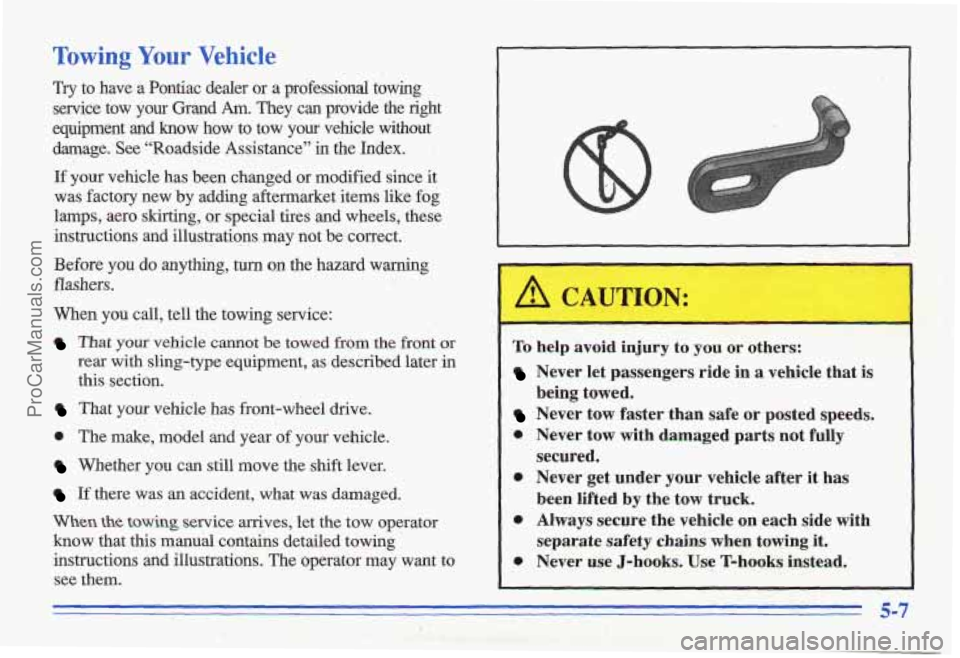
Towing Your Vehicle
Try to have a Pontiac dealer or a professional towing
service tow your Grand
Am. They can provide the right
equipment and know how to tow
your vehicle without
damage. See “Roadside Assistance”
in the Index.
If your vehicle has been changed or modified since it
was factory new by adding aftermaxket items like fog
lamps, aero skirting, or special tires and wheels, these
instructions and illustrations may not be’correct.
Before
you do anything, turn on the hazard warning
flashers.
When you call, tell the towing service:
That your vehicle cannot be towed from the front or
rear with sling-type equipment, as described later in
this section.
That your vehicle has front-wheel drive.
0 The make, model and year of your vehicle.
Whether you can still move the shift lever.
If there was an accident, what was damaged.
When the towing service arrives, let the tow operator
know that this manual contains detailed towing
instructions and illustrations. The operator may want to see them.
L
,I A CAUTION:
I To help avoid injury to you or others:
Never let passengers ride in a vehicle that is
Never tow faster than safe or posted speeds.
0 Never tow with damaged parts not fully
secured.
0 Never get under your vehicle after it has
been lifted
by the tow truck.
0 Always secure the vehicle on each side with
separate
safety chains when towing it.
0 Never use J-hooks. Use T-hooks instead.
being towed.
5-7
ProCarManuals.com
Page 211 of 356
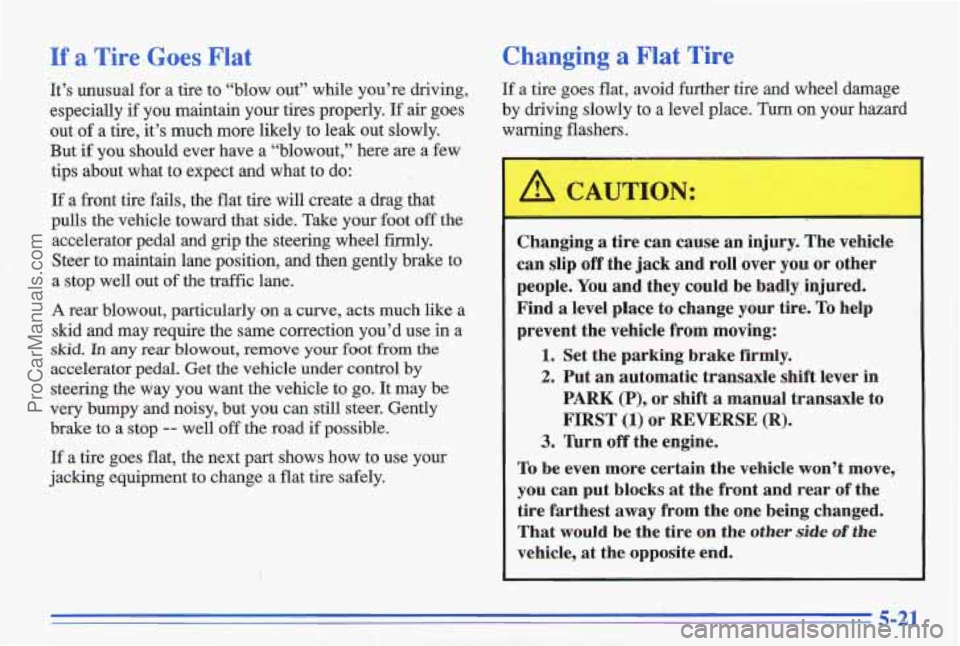
If a Tire Goes Flat
It’s unusual for a tire to “blow out” while you’re \
driving,
especially
if you maintain your tires properly. If air goes
out
of a tire, it’s much more likely to leak out slowly.
But
if you should ever have a “blowout,” here are a few
tips about what to expect and what to
do:
If a front tire fails, the flat tire will create a drag that
pulls the vehicle toward that side. Take your foot off the
accelerator pedal and grip the steering wheel firmly.
Steer
to maintain lane position, and then gently ‘brake to
a stop well out
of the traffic lane.
A rear blowout, particularly on a curve, acts much like a
skid and may require the same correction you’d use in a
skid. In my rear blowout, remove your foot from the
accelerator pedal. Get the vehicle under control by
steering the way you want the vehicle to
go. It may be
very bumpy and noisy, but you can
still steer. Gently
brake to a stop
-- well off the road if possible.
If a tire goes flat, the next part shows how to use your
jacking equipment to change a flat tire safely.
Changing a Flat Tire
If a tire goes flat, avoid further tire and wheel damage
by driving slowly
to a level place. Turn on your hazard
warning flashers.
Changing a tire can cause an injury. The vehicle
can slip
off the jack and roll over you or other
people.
You and they could be badly,injured.
Find
a level place to change your tire. To help
prevent the vehicle from moving:
1. Set the parking brake firmly.
2. Put an’automatic transaxle shift lever in
PARK
(P), or shift a manual transaxle to
FIRST (1) or REVERSE (R).
3. lbrn off the engine.
To be even more certain the vehicle won’t move,
you can put blocks at the front and rear of the
tire farthest away from the one being changed.
That would be the tire
on the other side of the
vehicle, at the opposite end.
5-21
ProCarManuals.com
Page 221 of 356
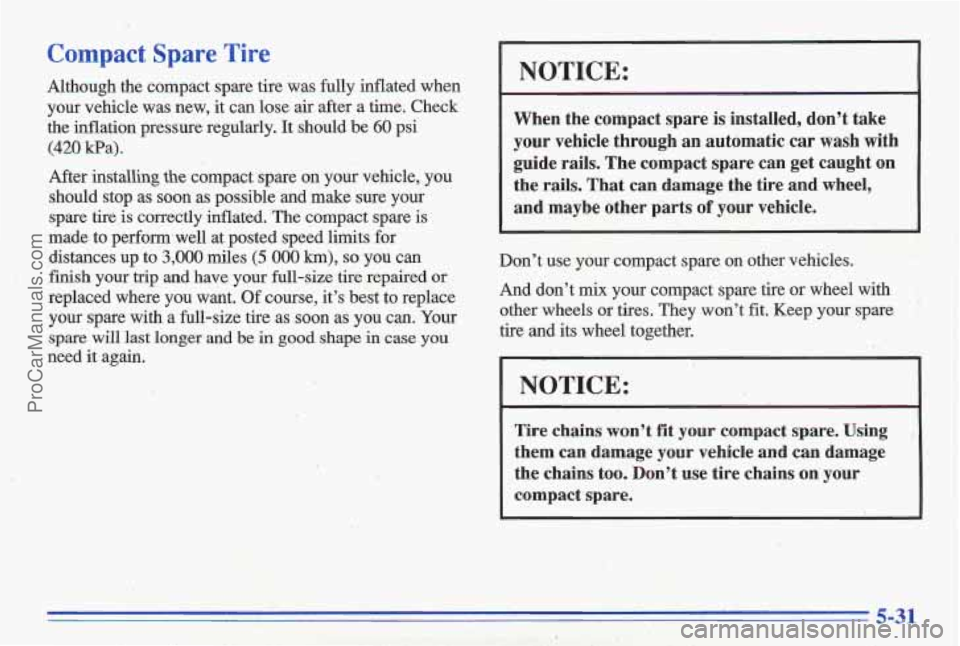
Compact Spare Tire
Although the compact spare tire was fully inflated’when
your vehicle was new, it can lose air after
a time. Check
the inflation pressure regularly.
It should be 60 psi
(42Q Wa).
After installing
the compact spare on your vehicle, you
should stop as soon as possible and make sure your
spare tire is correctly inflated. “The compact spare is
made to perfonnwell at posted speed limits for
distances up to.3,OOO miles
(5 000 km), so you can
finish your trip
and have your full-size tire repaired or
replaced where you want. Of course, it’s best to replace
your spare with a full-size tire as soon as you can. Your
spare
will last longer and be in good shape in case you
need it again.
NOTICE:
When the compact spare is installed, don’t take
your vehicle through,an automatic
car wash with
guide rails. The compact spare can get caught
on
the rails. That can damage the tire and wheel,
and maybe’ other parts
of your vehicle.
Don’t use your compact spare on other vehicles.
And don’t
mix your compact spare tire or wheel with
other wheels or tires. They won’t fit. Keep your spare
tire and its wheel together.
i
NOTICE:
Tire chains won’t fit your compact spare. Using
them can damage your vehicle and can damage
,the chains too. Don’t use tire chains on’-your
compact spare.
5-31
ProCarManuals.com
Page 222 of 356
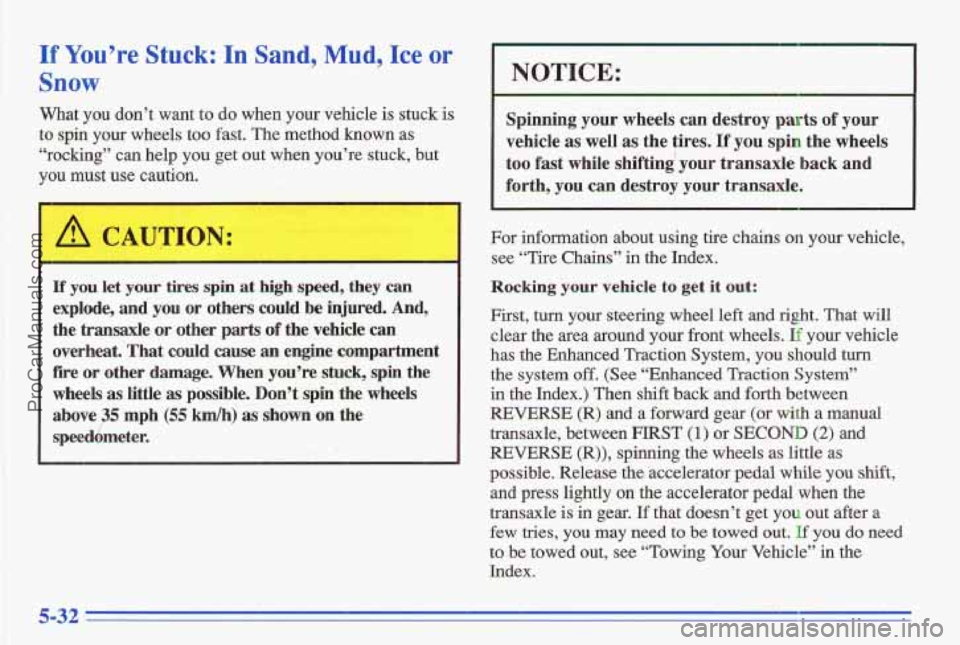
If You’re Stuck: In Sand,,Mud, Ice or
Snow
What you don’t want to do when your vehicle is stuck is
to spin your wheels too fast. The method known a,s
“rocking” can help you get out when you’re stuck, but
you must use caution.
/d CAUTION:
If you your .es spin at high speed, they can
explode, and you or others could be injured. And,
the tran,saxle or other parts of the vehicle can
overheat.
That could cause an engine compartment
fire or other damage. When you’re stuck, spin the
wheels
as little as possible. Don’t spin the wheels
above35 mph
(55 kdh) as shown on the
speedqmeter. Spinning
your wheels can destroy
parts of your
vehicle as well
as the tires. If you spin the wheels
too fast while shifting your transaxle back and
For information about using tire chains on your vehicle,
see “Tire Chains” in the Index.
Rocking y---r vehick ID get it out:
First, turn your steering wheel left and right. That will
clear the pea around your front wheels. If your vehicle
has the Enhanced Traction System, you should turn
the system
off. (See “Enhanced Traction System’’
in the Index.) Then shift back and forth between
REVERSE (R) and a forward gear
(or with a manual
transaxle, between FIRST
(1) or SECOND (2) and
REVERSE
(R)), spinning the wheels as little as
possible. Release the accelerator pedal
while you shift,
and press lightly on the accelerator pedal when the
transaxle is in gear.
If that doesn’t get you out after a
few tries, you may need to be towed out. If you do need
to be towe’d out, see “Towing Your Vehicle” in the
Index.
5-32
ProCarManuals.com
Page 253 of 356

NOTICE:
I I
Continuing to drive with worn-out brake pads
could result in costly brake repair.
Some driving conditions or climates may cause a brake
squeal when the brakes
are first applied or lightly
applied. This does not mean something
is wrong with
your brakes.
Free movement
of brake calipers and properly torqued
wheel nuts are necessary to help prevent brake
pulsation. When tires are rotated, inspect brake calipers
for movement, brake pads for wear, and evenly torque
wheel nuts in the proper sequence to
GM specifications.
Your rear drum brakes don't have wear indicators, but
if
you ever hear a rear brake rubbing noise, have the rear
brake linings inspected.
Also, the rear brake drums
should be removed and inspected each time the tires
are
removed for rotation or changing. When you have the
front brakes replaced, have the rear brakes inspected, too.
Brake linings should always be replaced as complete
Brake Pedal Travel
See your dealer if the brake pedal does not return to
normal height, or if there is a rapid increase in pedal
travel. This could be a sign
of brake trouble.
Brake Adjustment
Every time you make a moderate brake stop, your disc
brakes adjust for wear.
If you rarely make a moderate ar
heavier stop, then your brakes might not adjust correctly.
If you drive in that way, then -- very carefully -- make
a few moderate brake stops about every 1,000 miles
(1 600 km), so your brakes will adjust properly.
If your brake pedal goes down farther than normal, your
rear drum brakes may need adjustment. Adjust them by
backing up
'and firmly applying the brakes a few times.
Replacing Brake System Parts
The braking system on a modem vehicle is complex. Its
many parts have to be
of top quality and work well
together
if the vehicle is to have really good braking.
Vehicles we design and teSt have top-quality
GM brake
parts in them,
as your Pontiac does when it is new.
When you replace parts
of your 'braking system -- for
example, when your brake linings wear down and you
have to have new
ones put in -- be sure you get new
genuine
GM replacement parts. If you don't, your
6-31
ProCarManuals.com
Page 259 of 356
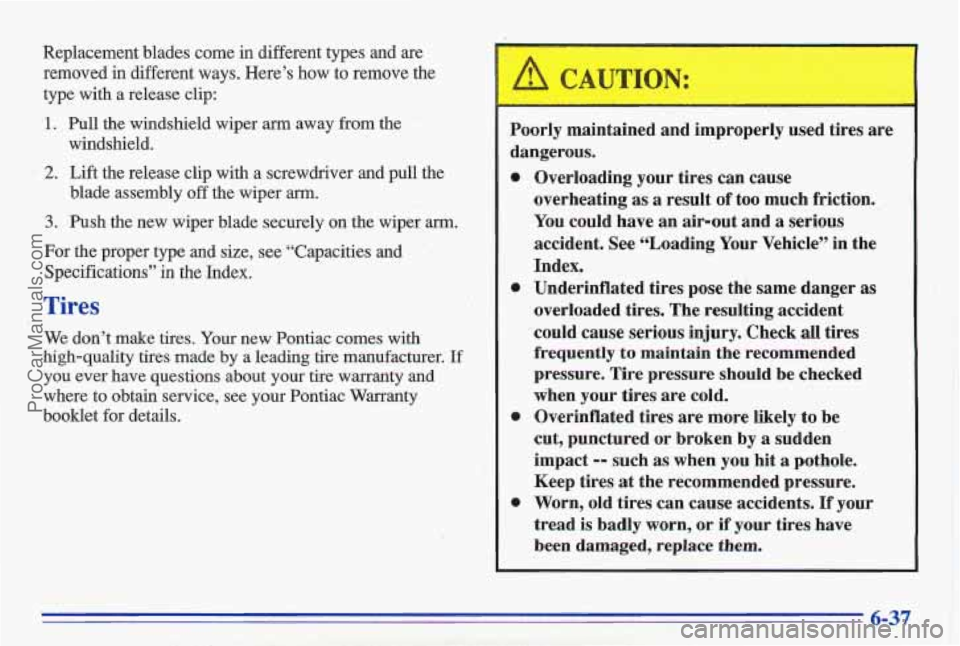
Replacement blades come in different types and are removed in different ways. Here’s how to remove the
type with a release clip:
1. Pull the windshield wiper am away from the ‘
2. Lift the release clip with a screwdriver and pull the
3. Push the new wiper blade securely on the wiper arm.
For the proper type and size, see “Capacities and
Specifications”
in the Index.
windshield.
blade assembly
off the wiper arm.
Tires
We don’t make tires. Your new Pontiac comes with
highquality tires made by a leading tire manufacturer. If
you ever have questions about your tire warranty and
where to obtain service, see your Pontiac Warranty
booklet for details.
.-
Poorly maintained and improperly used tires are
dangerous.
Overloading your tires can cause
overheating as
a result of too much friction.
You could have an air-out and a serious
accident. See “Loading Your Vehicle” in the
Index.
Underinflated tires pose the same danger as
overloaded tires. The resulting accident
could cause serious injury.
Check all tires
frequently
to maintain the recommended
pressure. Tire pressure should be checked
when your tires are cold.
Overinflated tires are more likely
to be
cut, punctured or broken
by a sudden
impact
-- such as when you hit a pothole.
Keep tires at the recommended pressure.
Worn, old tires can cause accidents.
If your
tread is badly worn, or
if your tires have
been damaged, replace
them.
6-37
ProCarManuals.com
Page 260 of 356
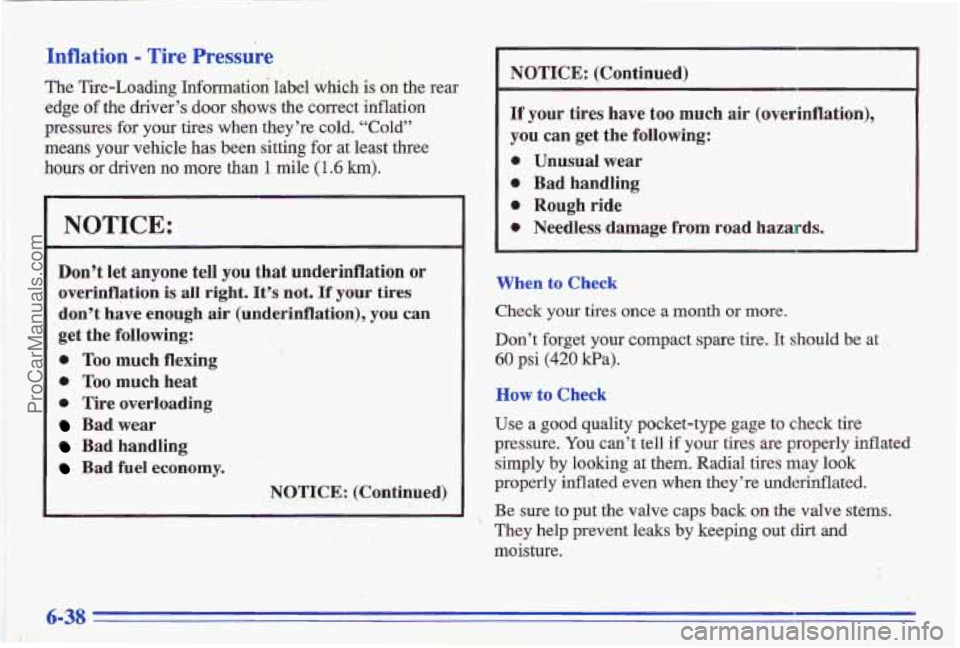
Inflation - Tire Pressure
The Tire-Lo,ading Information label which is on the rear
edge
of the driver’s door shows the correct inflation
preissures for your tires when they’re
cold. “Cold”
means your vehicle has
been sitting for at least three
hours or driven no more than 1 mile (1.6 km).
~~ ~~ ~~
NOTICE:
Don’t let anyone tell you that underinflation or
overinflation is all right. It’s not. 1% your tires
don’t have enough air (underinflation),, you can
get the following:
0 Too much flexing
0 Too much heat
0 Tire overloading
Bad wear
Bad handling
Bad fuel economy.
NOTICE: (Continued)
~~ ~~
NOTICE: (Continued)
If
your tires
have too much air (overinflation),
you can get the following:’
e Unusual wear
* Bad handling
* Rough ride
e Needless damage from road hazards.
When to Check
Check your tires once a month or more.
Don’t forget your compact spare tire. It should
be at
60 psi (420 Wa).
How to Check
Use a good quality pocket-type gage to check tire
pressure.
You can’t tell if your tires are properly inflated
simply
by looking at them. Radial tires may look
properly inflated even when they’re underinflated.
Be sure
to put the valve caps back on the valve stems.
They help prevent leaks by keeping out dirt and
moisture.
6-38
ProCarManuals.com
Page 261 of 356

Tire Inspection and Rotation
Tires should be inspected every 6,000 to 8,000 miles
(10 000 to 13 000 km) for any signs of unusual wear.
If unusual wear is present, rotate your tires as soon as
possible and check wheel alignment. Also check for damaged tires or wheels. See “When It’s Time for New
Tires” and “Wheel Replacement” later in this section for
more information. When rotating your tires, always use the correct rotation
pattern shown here.
Don’t include
the compact.spa.re tire in your tire
rotation.
After the tires have been rotated, adjust the front and
rear inflation pressures as shown on the Tire-Loading
Information label. Make certain that all wheel nuts are
properly tightened. See “Wheel Nut Torque” in the
Index.
I
The purpose of regular rotation is to achieve more
uniforrn wear for all tires on the vehicle. The first
rotation is the most important. See “Scheduled Maintenance Services”
in the Index for scheduled
rotation intervals.
--
Rust or dirt on a wheel, lr on the part D which
it is fastened, can make wheel nuts become loose
after
a time. The wheel could come off and cause
an accident. When
you change a wheel, remove
any rust or- dirt from places where the wheel
attaches to the vehicle. In an emergency,
you can
use
a cloth or a paper towel to do this; but be
sure to use
a scraper or wire brush later, if you
need to, to get all the rust or dirt off. (See
“Changing
a Flat Tire” in the ‘Index.)
6-39
ProCarManuals.com